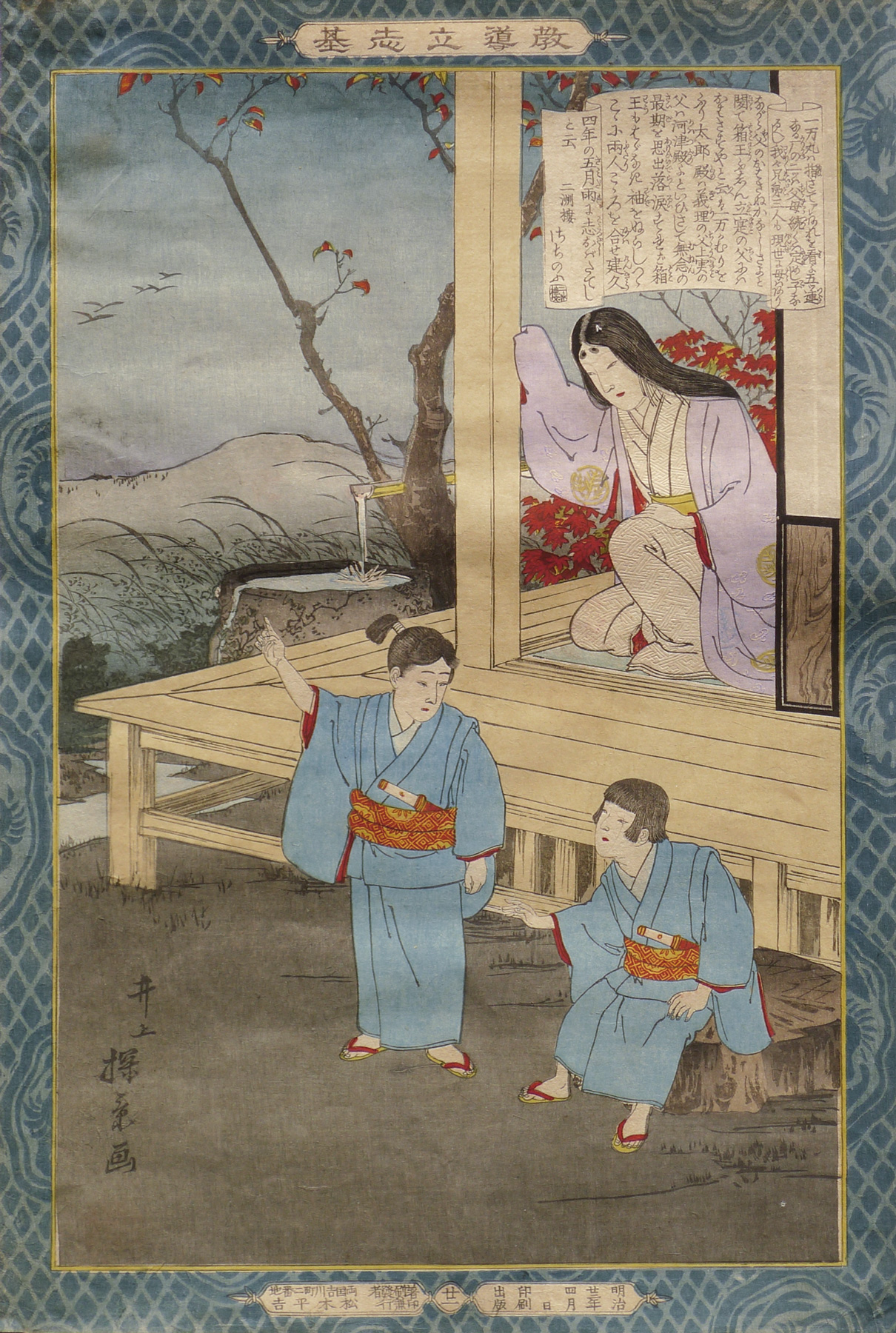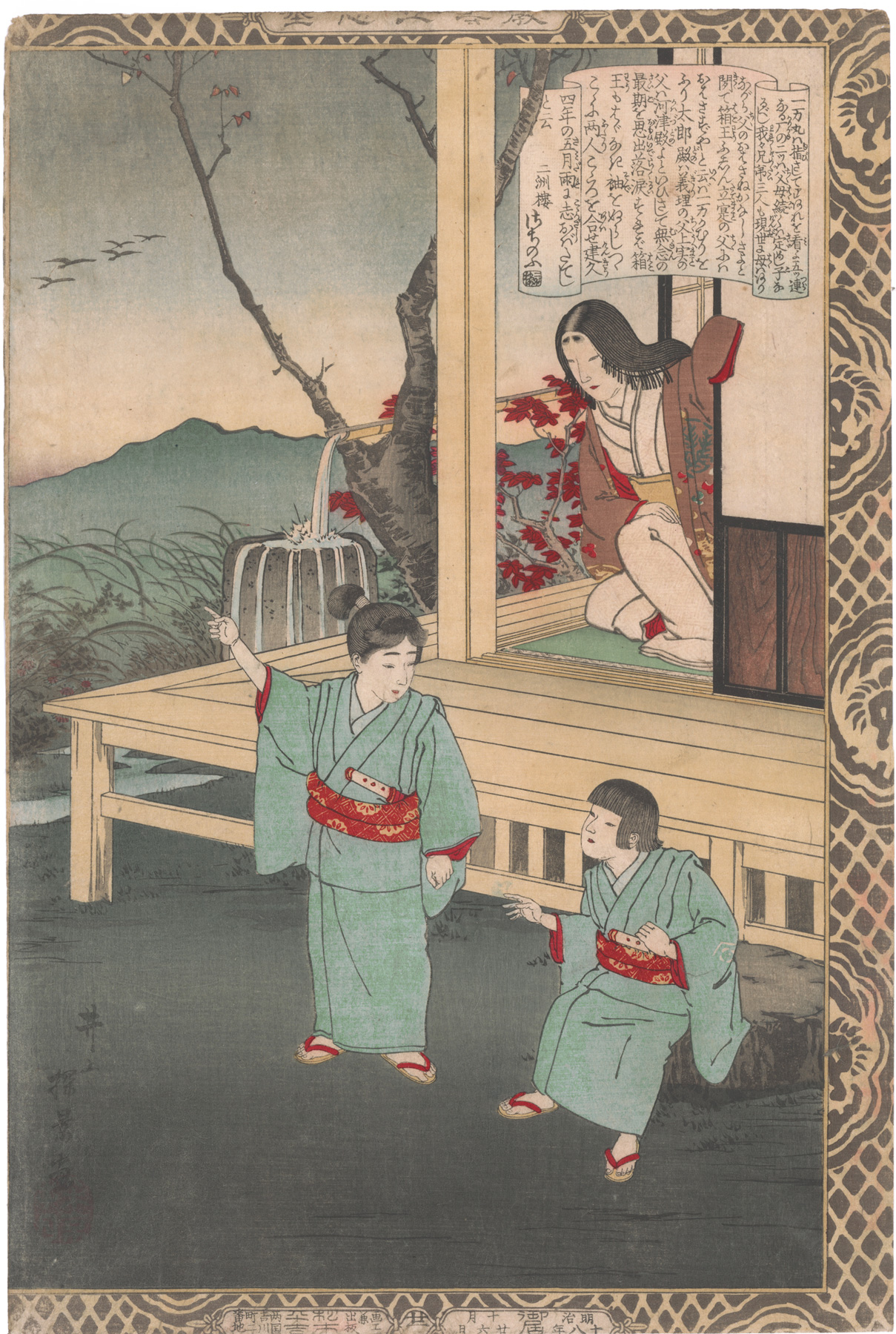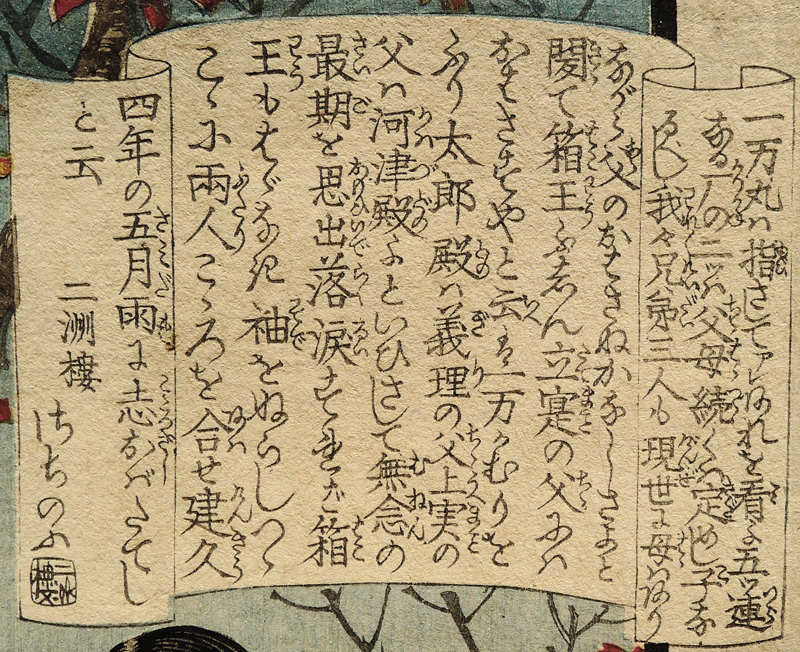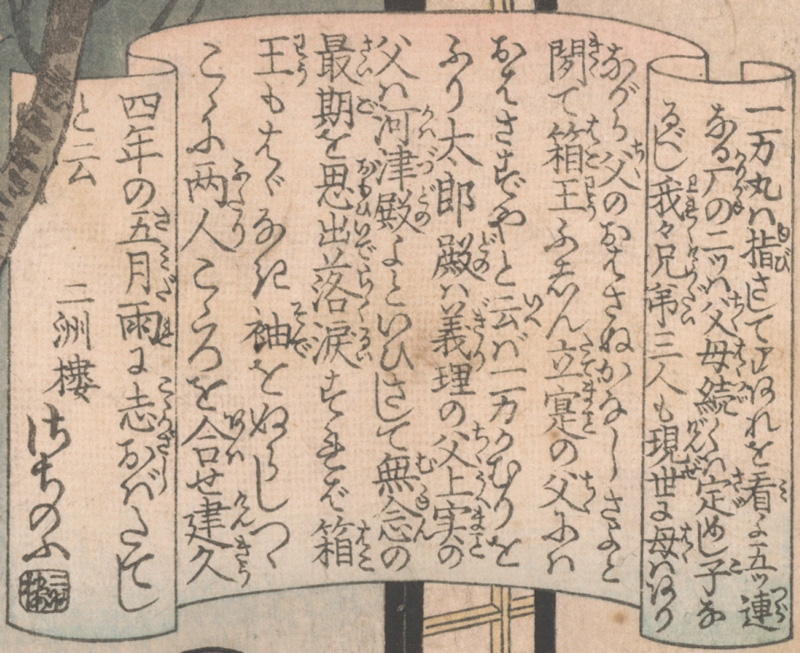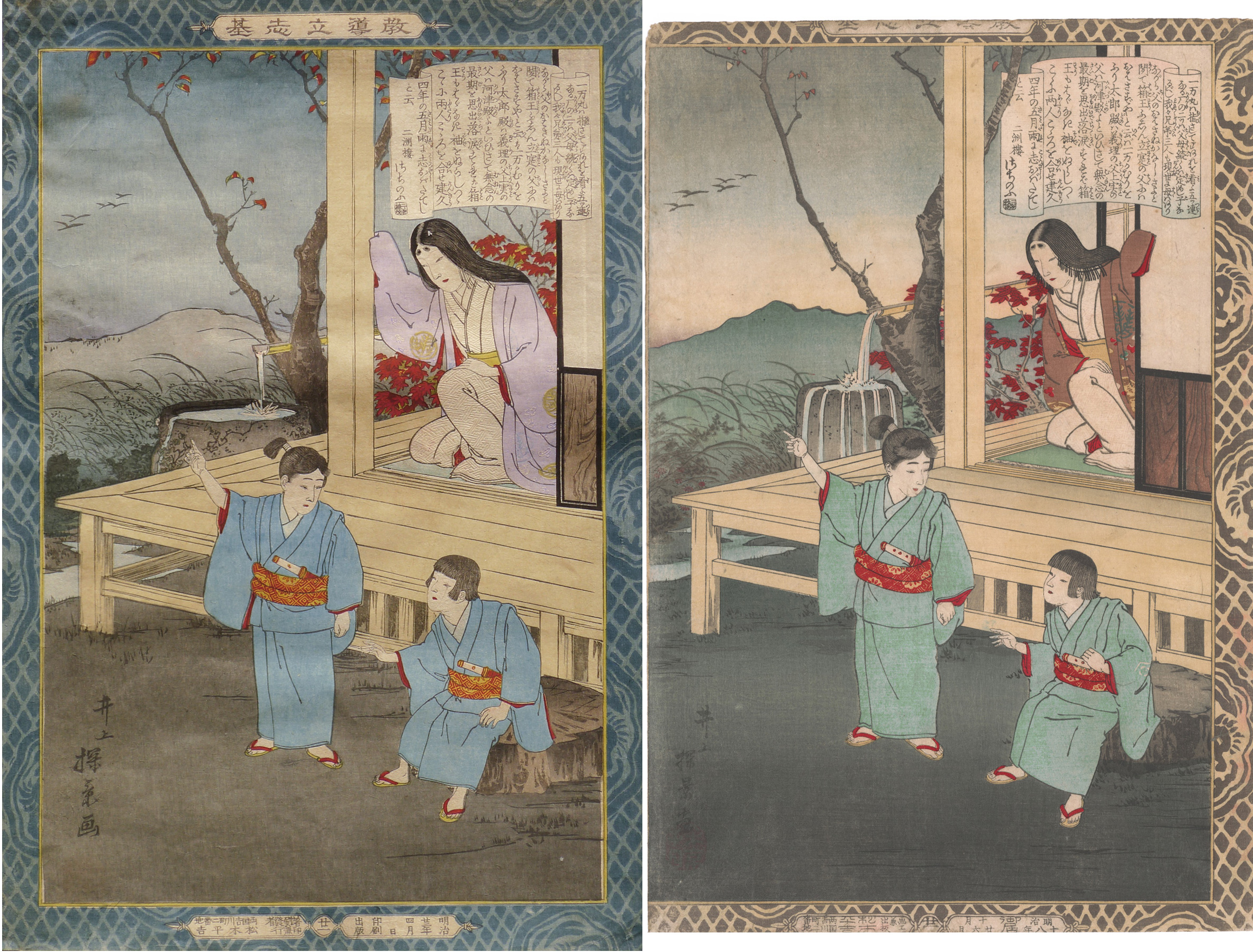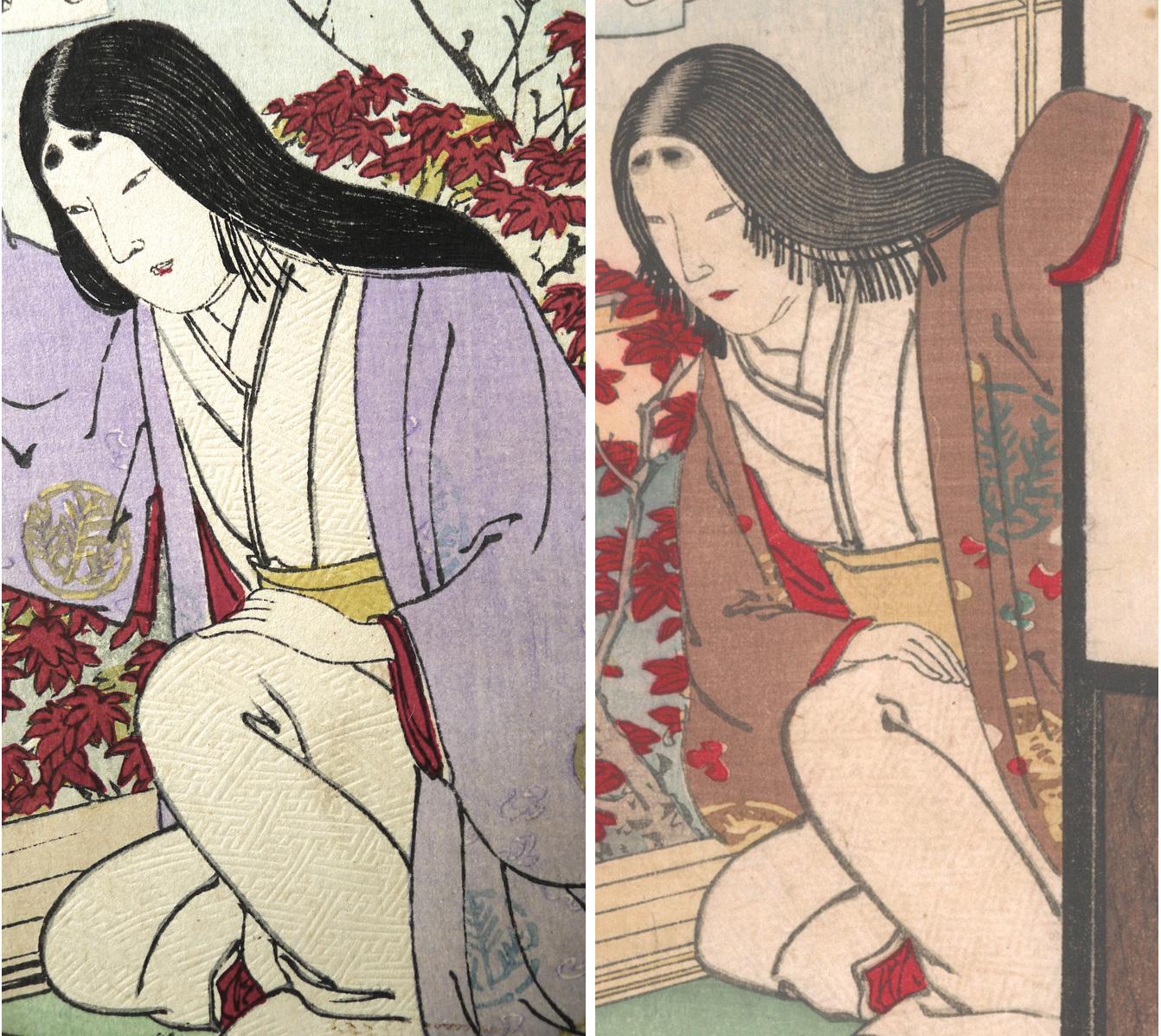About This Print
Print number 廿一 (21)1 in the series Instructive Models of Lofty Ambition picturing the young Soga Brothers and their mother. Five year old Juro points to five wild geese flying by to remind his younger brother Goro of their duty to avenge their murdered natural father while their mother peers fondly at them.The original blocks created in October 1885 for this print (see "Changed Blocks" below) were likely damaged or lost, and this collection contains both the original 1885 design (IHL Cat. #1352) and the April 1889 release (IHL Cat. #622). For detailed side-by-side comparisons on the two prints see
Inoue, a student of Kobayashi Kiyochika, contributed thirteen prints to this series. He was to die at the age of 25 in 1889, the year this print was issued.
1 Numbering of the prints was haphazard during the production of the series. Print numbers were sometimes inadvertently omitted; some prints in the series were never assigned numbers and a few of the same numbers appear on different prints.
The Story of the Soga Brothers
In 12th century Japan, Kudo Suketsune 工藤祐経 murders Kawazu-Saburo, the father of two young boys, 5 year old Ichiman-maru 一万丸 and 3 year old Hako-o-maru 箱王丸, over an inheritance. Their mother, Mango, tells the boys to avenge his death when they grow up. When their mother remarries a kindly man named Soga, they take his name becoming Soga-Juro-Sukenari and Soga-Goro-Tokimune, but they do not forget their duty.
One day while playing in the yard the boys see five wild geese flying by. Looking at the geese, Juro says to Goro, "Look at them. They were flying in a line. Maybe two are parent geese and three their children. I live with you and our mother. But Soga is our stepfather. Our real father was killed by Kudo. I've missed my biological father."
His younger brother Goro then loudly says, "When I meet Kudo, I'll shoot him and cut off his head."
But Juro scolded his brother for his careless loud talk by saying "Be quiet. Don't tell anyone about our plan. It's a secret between us."
It was not until the 18th day of the fifth month of 1193, when Juro was 22 years old and Goro 20, that they got their revenge, killing Kudo-Suketsune. Juro was killed right after the attack and Goro was executed later saying: "Give me death. I've been resolved to die. I want to meet my father and brother in the next world as soon as possible."
This story is told in The Tale of the Soga Brothers (Soga monogatari 曽我物語) written in the late Kamakura period (1185–1333.)
1 Numbering of the prints was haphazard during the production of the series. Print numbers were sometimes inadvertently omitted; some prints in the series were never assigned numbers and a few of the same numbers appear on different prints.
The Story of the Soga Brothers
In 12th century Japan, Kudo Suketsune 工藤祐経 murders Kawazu-Saburo, the father of two young boys, 5 year old Ichiman-maru 一万丸 and 3 year old Hako-o-maru 箱王丸, over an inheritance. Their mother, Mango, tells the boys to avenge his death when they grow up. When their mother remarries a kindly man named Soga, they take his name becoming Soga-Juro-Sukenari and Soga-Goro-Tokimune, but they do not forget their duty.
One day while playing in the yard the boys see five wild geese flying by. Looking at the geese, Juro says to Goro, "Look at them. They were flying in a line. Maybe two are parent geese and three their children. I live with you and our mother. But Soga is our stepfather. Our real father was killed by Kudo. I've missed my biological father."
His younger brother Goro then loudly says, "When I meet Kudo, I'll shoot him and cut off his head."
But Juro scolded his brother for his careless loud talk by saying "Be quiet. Don't tell anyone about our plan. It's a secret between us."
It was not until the 18th day of the fifth month of 1193, when Juro was 22 years old and Goro 20, that they got their revenge, killing Kudo-Suketsune. Juro was killed right after the attack and Goro was executed later saying: "Give me death. I've been resolved to die. I want to meet my father and brother in the next world as soon as possible."
This story is told in The Tale of the Soga Brothers (Soga monogatari 曽我物語) written in the late Kamakura period (1185–1333.)
Transcription of Scroll
click on scroll to enlarge
21 Soga Brothers 曾我兄弟
教導立志基 廿一 曾我兄弟 井上探景(安治) 1885年10月26日
教導立志基 廿一 曾我兄弟 井上探景(安治) 1885年10月26日
Transcription:
“一万丸ハ指さして アレあれを看よ五つ連なる厂(雁 かりがね)の二ツハ父母 続くハ定めし子なるべし 我々兄弟三人も現世に母ハありながら父のおわさぬかなしさよ と 聞て箱王ふしん立 寔(まこと)の父にハおわさずや と 云バ一万かむりをふり 太郎殿ハ義理の父上 実の父ハ河津殿よといひさして無念の最期を思出落涙すれば箱王もすぐなき袖をぬらしつゝ こゝに兩人こゝろを合せ建久四年の五月雨に志をバたてしと云 二洲樓さちのぶ”
Comparison of April 1889 and October 1885 Designs
click on image to enlarge
Detail comparison of Mother
click on image to enlarge
About The Series "Kyōdō risshi no motoi"
Notes:1. This series is variously translated as "Instructive Models of Lofty Ambition," "Foundations of Learning and Achievement," "Foundation of Instruction and Perseverance," "Self-Made Men Worthy of Emulation," "Paragons of Instruction and Success," "Moral of Success," "Examples of Self-Made Leaders," and "Instruction in the Fundamentals of Success." The title in Japanese is sometimes seen as "Kyōdō risshiki or "Kyōdō risshi no moto," in addition to the most commonly seen transliteration of "Kyōdō risshi no motoi".2. For a complete listing of all the prints in the series and additional information please see the article on this site titled Instructive Models of Lofty Ambition.
This series ran between October 1885 and November 1890 and featured a long list of heroes and heroines, from antiquity to contemporary times, who were regarded as standards of moral leadership and self-realization.
Source: Kiyochika Artist of Meiji Japan, Henry D. Smith II, Santa Barbara Museum of Art, 1988, p. 74-75; original research and as footnoted.
This series of 58 prints,1 plus a table of contents sheet (目録), were originally published between October 1885 and November 1890 by the Tokyo publisher Matsuki Heikichi 松木平吉.2 The table of contents sheet issued by the publisher states that "fifty prints make up the complete set (五十番揃)". Three prints not in the initial release were added over the five year publication period, as were five redesigns of original prints, eventually increasing the total print count to 58. The seven artists contributing prints were Kobayashi Kiyochika (1847-1915) [20 prints], Mizuno Toshikata (1866-1908) [16 prints], Inoue Tankei (Yasuji) (1864-1889) [13 prints], Taiso (Tsukioka) Yoshitoshi (1839-1892) [5 prints], Yōshū Chikanobu (1838-1912) [2 prints], Toyohara Kunichika (1835–1900) [1 print], and Hachisuka (Utagawa) Kuniaki II (1835-1888) [1 print]. All the artists, with the exception of Yōshū Chikanobu, are listed in the top scroll of the table of contents sheet. Various colors (including blue, blue/green, and tan/brown) were used for the decorative border, and in 1902 the series was re-issued by Matsuki without borders.
Brief texts contained within a scroll-like cartouche appearing on each print provide historical details. The scroll composer's name is given at the end of the scroll text. The “lofty ambition” of the title is a Confucian concept, originally from Mencius, meaning “righteous determination that would inspire others.” The market for the series probably included former samurai, ambitious youth, and conservative intellectuals.
"[W]hen it was completed in 1890 the publisher was singled out for special recognition by the government for having sponsored such noble subject matter."3
This series ran between October 1885 and November 1890 and featured a long list of heroes and heroines, from antiquity to contemporary times, who were regarded as standards of moral leadership and self-realization.
Source: Kiyochika Artist of Meiji Japan, Henry D. Smith II, Santa Barbara Museum of Art, 1988, p. 74-75; original research and as footnoted.
This series of 58 prints,1 plus a table of contents sheet (目録), were originally published between October 1885 and November 1890 by the Tokyo publisher Matsuki Heikichi 松木平吉.2 The table of contents sheet issued by the publisher states that "fifty prints make up the complete set (五十番揃)". Three prints not in the initial release were added over the five year publication period, as were five redesigns of original prints, eventually increasing the total print count to 58. The seven artists contributing prints were Kobayashi Kiyochika (1847-1915) [20 prints], Mizuno Toshikata (1866-1908) [16 prints], Inoue Tankei (Yasuji) (1864-1889) [13 prints], Taiso (Tsukioka) Yoshitoshi (1839-1892) [5 prints], Yōshū Chikanobu (1838-1912) [2 prints], Toyohara Kunichika (1835–1900) [1 print], and Hachisuka (Utagawa) Kuniaki II (1835-1888) [1 print]. All the artists, with the exception of Yōshū Chikanobu, are listed in the top scroll of the table of contents sheet. Various colors (including blue, blue/green, and tan/brown) were used for the decorative border, and in 1902 the series was re-issued by Matsuki without borders.
This series of 58 prints,1 plus a table of contents sheet (目録), were originally published between October 1885 and November 1890 by the Tokyo publisher Matsuki Heikichi 松木平吉.2 The table of contents sheet issued by the publisher states that "fifty prints make up the complete set (五十番揃)". Three prints not in the initial release were added over the five year publication period, as were five redesigns of original prints, eventually increasing the total print count to 58. The seven artists contributing prints were Kobayashi Kiyochika (1847-1915) [20 prints], Mizuno Toshikata (1866-1908) [16 prints], Inoue Tankei (Yasuji) (1864-1889) [13 prints], Taiso (Tsukioka) Yoshitoshi (1839-1892) [5 prints], Yōshū Chikanobu (1838-1912) [2 prints], Toyohara Kunichika (1835–1900) [1 print], and Hachisuka (Utagawa) Kuniaki II (1835-1888) [1 print]. All the artists, with the exception of Yōshū Chikanobu, are listed in the top scroll of the table of contents sheet. Various colors (including blue, blue/green, and tan/brown) were used for the decorative border, and in 1902 the series was re-issued by Matsuki without borders.
Brief texts contained within a scroll-like cartouche appearing on each print provide historical details. The scroll composer's name is given at the end of the scroll text. The “lofty ambition” of the title is a Confucian concept, originally from Mencius, meaning “righteous determination that would inspire others.” The market for the series probably included former samurai, ambitious youth, and conservative intellectuals.
"[W]hen it was completed in 1890 the publisher was singled out for special recognition by the government for having sponsored such noble subject matter."3
1 The Tokyo Metropolitan Library online collection shows 50 prints and a Table of Contents sheet. The Table of Contents lists the titles of 50 prints. Smith in Kiyochika Artist of Meiji Japan identified 52 prints. I have identified 58 prints from this series including five prints (Ikina, Michizane Sugiwara, Kesa Gozen, Soga Brothers and Hokiichi Hanawa) that were re-designed and re-printed, likely due to damaged or lost blocks.
2 Robert Schaap notes in Appendix II, p. 166 of Yoshitoshi, Masterpieces from the Ed Freis Collection, Chris Uhlenbeck and Amy Reigle Newland, Hotei Publishing, 2011 that the series originally appeared as newspaper supplements.
3 The World of the Meiji Print: Impressions of a New Civilization, Julia Meech-Pekarik, Weatherhill, 1986, p. 122.
1 The Tokyo Metropolitan Library online collection shows 50 prints and a Table of Contents sheet. The Table of Contents lists the titles of 50 prints. Smith in Kiyochika Artist of Meiji Japan identified 52 prints. I have identified 58 prints from this series including five prints (Ikina, Michizane Sugiwara, Kesa Gozen, Soga Brothers and Hokiichi Hanawa) that were re-designed and re-printed, likely due to damaged or lost blocks.
2 Robert Schaap notes in Appendix II, p. 166 of Yoshitoshi, Masterpieces from the Ed Freis Collection, Chris Uhlenbeck and Amy Reigle Newland, Hotei Publishing, 2011 that the series originally appeared as newspaper supplements.
3 The World of the Meiji Print: Impressions of a New Civilization, Julia Meech-Pekarik, Weatherhill, 1986, p. 122.
Print Details
| IHL Catalog | #622, #1352 | ||
| Title or Description | Soga Brothers 曾我兄弟 | ||
| Series | “Instructive Models of Lofty Ambition” (Kyodo risshiki 教導立志基) [note: seriestitle also listed as 'Kyodo Risshi no Moto', ‘Kyodo risshi no motoi’,‘Kyōdō risshi ki’ and variously translated as “Moral of success” or“Foundations of learning and achievement” or “Self-made Men Worthy ofEmulation”' or “Examples of Self-made Leaders” or "Paragons of instruction and success"] | ||
| Artist | Inoue Yasuji (1864-1889) | ||
| Signature |
| ||
| Seal | #622 unsealed; #1352 Tankei seal | ||
| Publication Date | Initial publication date October 26, 1885 and subsequently re-issued with new design using new blocks in April 1889. | ||
| Publisher | Matsuki Heikichi (松木平吉) proprietor of Daikokuya Heikichi [Marks: seal not shown; pub. ref. 029] (from right to left) publishing and printing date: 明治廿二年 四月 日 印刷 出版 [notification delivered, Meiji 22nd year 4th month day] assigned number within series: 廿一 [21] publisher information: 著刷發者 両国吉川町二番地 印兼行 松v平吉 [publisher and printer Ryōgoku Yoshikawachō 2-banchi Matsuki Heikichi] click on image to enlarge (from right to left) publishing and printing date: 明治十八年 届御 十月 廿六日 [notification delivered, Meiji 18th year 10th month 26th day] assigned number within series: 廿一 [21] publisher information: 画工兼著出版 松木平吉 [in seal script] 両国吉川町二番地 [artist and publisher Matsuki Heikichi Ryōgoku Yoshikawachō 2-banchi] | ||
| Impression | IHL Cat. #622 - excellent; IHL Cat. #1352 - excellent | ||
| Colors | IHL Cat. #622 - excellent; IHL Cat. #1352 - excellent | ||
| Condition | IHL Cat. # 622 - excellent - full size; not backed; minor wrinkling IHL Cat. #1352 - fair - trimmed into brocade border top and bottom; trimmed to image left side; unbacked; minor rubbing and soiling | ||
| Genre | ukiyo-e; rishki-e; kyōiku nishiki-e | ||
| Miscellaneous | print number 21 (廿一); position 17 in the Table of Contents for the series | ||
| Format | vertical oban | ||
| H x W Paper | IHL Cat. #622 - 14 x 9 3/8 in. (35.5 x 23.8 cm) IHL Cat. #1352 - 13 9/16 x 8 7/8 in. (34.4 x 22.5 cm) | ||
| H x W Image | IHL Cat. #622 - 12 9/16 x 8 3/16 in. (31.2 x 20.6 cm) IHL Cat. #1352 - 12 5/8 x 8 3/16 in. (31.2 x 20.6 cm) | ||
| Literature | |||
| Collections This Print | The Tsubouchi Memorial Theatre Museum of Waseda University 012-0962 (1885 release using different blocks); Tokyo Metropolitan Library H041-004 (1885 release using different blocks) |
4/10/2021


